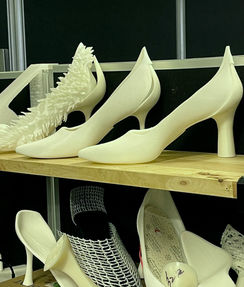
BACKGROUND RESEARCH
Computational design is a method that allows for rapid iterative design, a tool that has the potential to be controlled by a customer. Traditional manufacturing follows the process of making a multitude of components which are then transported and constructed using adhesives. This creates an assembly system that is layered with negative side effects such as deconstruction and recycling difficulties (Rensburg et al., 2020). The large scale of inventory raises the issue of transport for such an intensive supply chain.
Some studies have suggested 3D printing enables unique benefits for increased freedom in manufacturing (Lin & Chen, 2015). While there are many case studies for 3D printed heels that are conceptual, artistic or high-end limited-edition pieces, only a small number have produced wearable 3D printed heels. A number of these designs are made of mono material which may be easier to recycle but may not have the same performance for style and structure as a traditional shoe.
With access to computational software and 3D printing processes, a parametric approach for mass customisation may be a more sustainable solution to address the demands of the contemporary context. This research demonstrates a possible parametric pathway that combines style, size and construction for a new manufacturing and distribution method of high heeled shoes. This technology application gives the ability to produce shoes on demand to fit the customer perfectly, eliminating size restrictions and reducing inventory.






